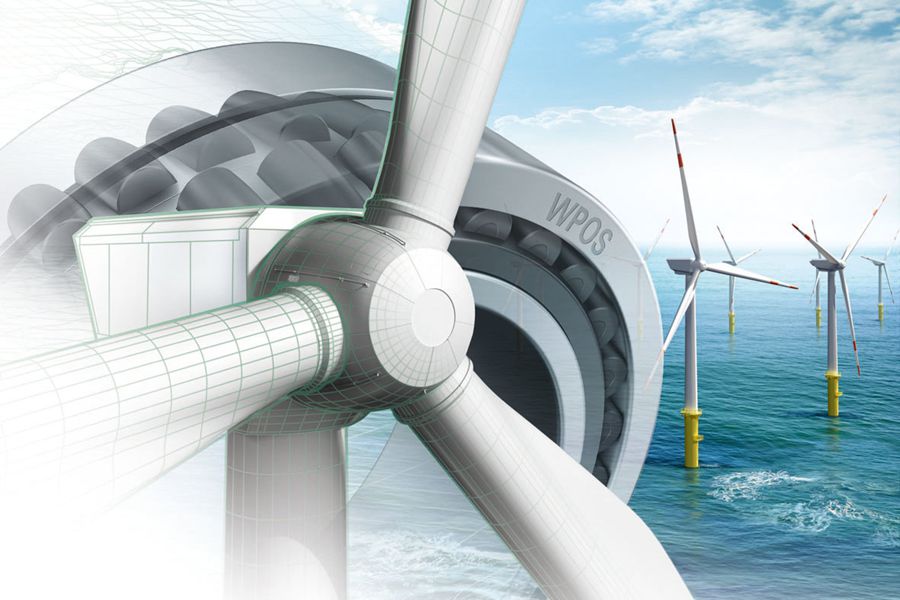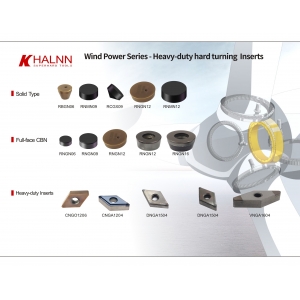Wind turbine gear hard turning is a critical process in the manufacturing of wind turbine gears, which are essential components for converting wind energy into electricity. As the demand for renewable energy grows, the efficiency and reliability of wind turbines become increasingly important. This article explores the role of hard turning in the production of wind turbine gears, highlighting its benefits, applications, and the advanced tools provided by Halnn Group to ensure precision and efficiency.

Hard turning is a machining process used to cut hard materials, typically with a hardness above 45 HRC (Rockwell Hardness). Unlike traditional grinding, hard turning utilizes single-point cutting tools to achieve precise dimensional tolerances and high-quality surface finishes. This process is particularly suited for manufacturing hard-wearing components, such as wind turbine gears.
While grinding has been the go-to method for finishing hardened materials, hard turning offers several advantages. It is generally faster, more flexible, and cost-effective. Hard turning can achieve similar, if not better, surface finishes and tolerances compared to grinding. Additionally, it reduces the number of process steps, leading to shorter production times.
Precision and Accuracy: Hard turning provides high dimensional accuracy and excellent surface finishes.
Efficiency: Faster processing times compared to grinding.
Cost Savings: Reduced tooling and machine setup costs.
Flexibility: Easier to switch between different geometries and materials.
Gears in wind turbines are responsible for increasing the rotational speed from the turbine blades to the generator. This process is crucial for efficiently converting wind energy into electrical power. The performance and longevity of wind turbine gears directly impact the overall efficiency and reliability of the turbines.
Precision and durability in gear manufacturing are vital to ensure smooth operation, reduce wear and tear, and minimize maintenance needs. High-quality gears lead to better energy conversion and longer turbine lifespan.
Producing gears for wind turbines presents several challenges, including:
Maintaining tight tolerances.
Ensuring surface finish quality.
Dealing with hard materials.
Minimizing production costs and time.
Hard turning is increasingly used in the production of wind turbine gears due to its ability to handle tough materials while maintaining high precision. This method streamlines the manufacturing process, allowing for efficient production of high-quality gears.

Reduced Production Steps: Hard turning combines roughing and finishing in one operation.
Lower Costs: Decreased tooling and setup costs.
Improved Flexibility: Easier adaptation to different gear designs and sizes.
To achieve optimal results in hard turning, specific technical requirements must be met:
High-Quality Machines: CNC lathes with high rigidity and precision.
Advanced Cutting Tools: Tools made from materials like Cubic Boron Nitride (CBN) or ceramics.
Optimal Conditions: Proper cutting parameters, cooling, and lubrication.
CBN Tools: Ideal for cutting hardened steels and cast irons.
Ceramic Tools: Suitable for high-speed machining of hard materials.
The tools used for hard turning must possess:
High Hardness: To withstand the cutting forces.
Wear Resistance: To maintain cutting efficiency over time.
Thermal Stability: To endure high temperatures without deforming.
Using high-quality tools ensures better performance, longer tool life, and superior surface finishes. Halnn Group offers a range of advanced hard turning tools designed to meet the rigorous demands of wind turbine gear manufacturing.
Cutting Speed: Affects tool wear and surface finish.
Feed Rate: Influences material removal rate and surface texture.
Depth of Cut: Determines the amount of material removed in a single pass.
Balancing Speed and Feed: Achieving the optimal combination for maximum efficiency and tool life.
Coolant and Lubrication: Ensuring proper cooling to prevent overheating and improve surface finish.
Regular Monitoring: Continuously checking tool wear and making necessary adjustments.
Quality control is critical in gear manufacturing. Techniques include:
Dimensional Inspections: Using coordinate measuring machines (CMM) to verify gear dimensions.
Surface Finish Analysis: Employing profilometers to measure surface roughness.
Hardness Testing: Ensuring the gears meet the required hardness specifications.
Tool Wear: Regularly inspect and replace worn tools.
Thermal Damage: Use appropriate cooling strategies.
Surface Imperfections: Optimize cutting parameters to achieve smooth finishes.
Halnn Group has partnered with several wind turbine manufacturers to implement hard turning solutions. These case studies demonstrate significant improvements in production efficiency, gear quality, and cost savings.
Cost Reduction: Lowered production costs due to fewer process steps and extended tool life.
Improved Efficiency: Faster production times and higher output.
Enhanced Gear Quality: Better dimensional accuracy and surface finishes.
Customers have praised Halnn Group for providing reliable and high-performance hard turning tools, contributing to their success in the competitive wind energy market.
Tool Wear: Frequent tool changes can disrupt production.
Thermal Management: Overheating can lead to tool failure and material damage.
Vibration: Can affect surface finish and dimensional accuracy.
Advanced Tool Materials: Using CBN and ceramic tools for better wear resistance.
Optimized Cooling: Implementing efficient cooling systems to manage heat.
Stable Machining Conditions: Ensuring machine rigidity and balanced cutting parameters.
Smart Tools: Integration of sensors for real-time monitoring and adjustments.
Automation: Increased use of automated systems for consistency and efficiency.
Sustainable Practices: Development of eco-friendly manufacturing processes.
Hard turning is more energy-efficient than traditional grinding, reducing the carbon footprint of gear manufacturing. Additionally, fewer process steps mean less waste generation.
Compared to grinding, hard turning uses less energy and generates less heat, contributing to a more sustainable manufacturing process.
Halnn Group is committed to promoting sustainable manufacturing through the development of eco-friendly tools and processes that minimize environmental impact.
Hard turning has revolutionized the manufacturing of wind turbine gears, offering precision, efficiency, and cost-effectiveness. By adopting advanced hard turning tools and techniques, manufacturers can enhance gear quality and contribute to the growth of the renewable energy sector. Halnn Group remains at the forefront of this technological advancement, providing top-tier tools and solutions for the wind energy industry.
Halnn Group is a leader in the development and supply of advanced hard turning tools. With a commitment to quality and innovation, Halnn Group offers a comprehensive range of products designed to meet the demanding needs of the wind turbine manufacturing industry. Our expertise and dedication to customer satisfaction have made us a trusted partner for manufacturers worldwide. Explore our range of products and services, and join us in driving the future of sustainable manufacturing. For more information, visit Halnn Group's official website: Halnncbn.
1. What is hard turning?
Hard turning is a precision machining process used to cut materials with a hardness above 45 HRC (Rockwell Hardness) using single-point cutting tools. It is often used as an alternative to grinding, offering similar precision and surface finish quality while being more flexible and cost-effective.
2. Why is hard turning preferred over grinding for wind turbine gears?
Hard turning is preferred over grinding for several reasons:
Efficiency: Hard turning is generally faster, reducing production time.
Cost-effectiveness: It reduces tooling and setup costs.
Flexibility: Easier to adapt to different geometries and materials.
Single Operation: Combines roughing and finishing in one step, simplifying the manufacturing process.
3. What types of tools are used in hard turning for wind turbine gears?
The primary tools used in hard turning are made from:
Cubic Boron Nitride (CBN): Known for its hardness and wear resistance, ideal for cutting hardened steel.
Ceramics: Excellent for high-speed machining of hard materials due to their thermal stability and wear resistance.
4. What are the key process parameters in hard turning?
The key process parameters in hard turning include:
Cutting Speed: The speed at which the cutting tool engages with the material.
Feed Rate: The rate at which the cutting tool moves along the surface of the material.
Depth of Cut: The thickness of the material layer removed in one pass.
Optimizing these parameters is crucial for achieving the desired surface finish and dimensional accuracy.
5. How does hard turning improve the quality of wind turbine gears?
Hard turning improves the quality of wind turbine gears by providing:
High Precision: Achieving tight dimensional tolerances.
Excellent Surface Finish: Producing smooth surfaces that enhance gear performance.
Consistency: Maintaining uniformity across multiple gears, which is critical for reliability.
6. What are the common challenges in hard turning wind turbine gears?
Some common challenges include:
Tool Wear: Due to the hardness of the materials being machined.
Thermal Management: Managing heat generated during the process to prevent tool and material damage.
Vibration: Maintaining stability to ensure precision and surface finish quality.
7. How can these challenges be addressed?
Challenges in hard turning can be addressed by:
Using High-Quality Tools: Selecting tools made from materials like CBN or ceramics that are designed for hard turning.
Optimizing Cutting Parameters: Balancing speed, feed, and depth of cut to minimize tool wear and thermal issues.
Proper Cooling and Lubrication: Implementing effective cooling strategies to manage heat.
Machine Stability: Ensuring the machining setup is rigid and stable to reduce vibrations.
8. What are the benefits of using Halnn Group’s hard turning tools?
Halnn Group’s hard turning tools offer several benefits:
Durability: Made from high-quality materials like CBN, ensuring long tool life.
Precision: Designed to achieve high dimensional accuracy and excellent surface finishes.
Cost Savings: Reduce tooling and setup costs through efficient machining.
Support and Expertise: Backed by Halnn Group’s extensive experience and customer support.
9. How does hard turning contribute to sustainability in gear manufacturing?
Hard turning contributes to sustainability by:
Reducing Energy Consumption: It is more energy-efficient compared to grinding.
Minimizing Waste: Fewer process steps result in less material waste.
Enhancing Tool Life: Longer-lasting tools reduce the need for frequent replacements.
10. What future trends are expected in hard turning technology for wind turbine gears?
Future trends in hard turning technology include:
Smart Tools: Integration of sensors for real-time monitoring and adaptive control.
Automation: Increased use of automated systems for consistent and efficient production.
Eco-friendly Practices: Development of more sustainable manufacturing processes and materials.
WhatsApp:8613271562251
Email:service@halnn-group.com
Address:R & D 5B, National University Science and Technology Park, National University, Changchun Road, Zhengzhou High-tech Zone